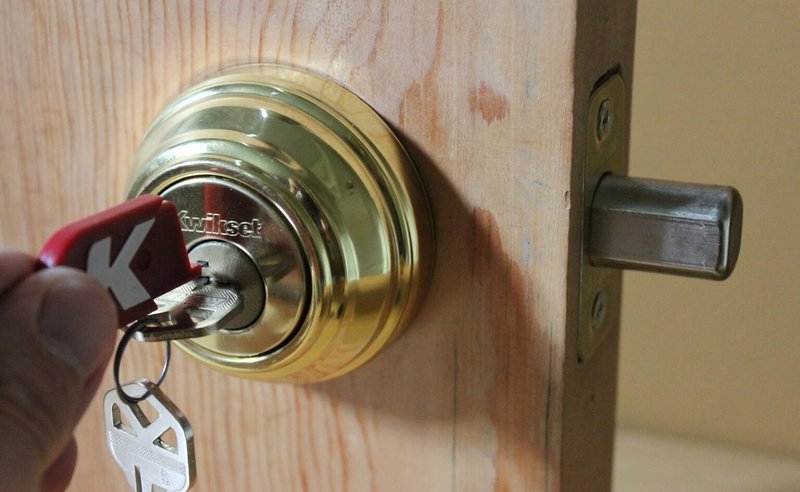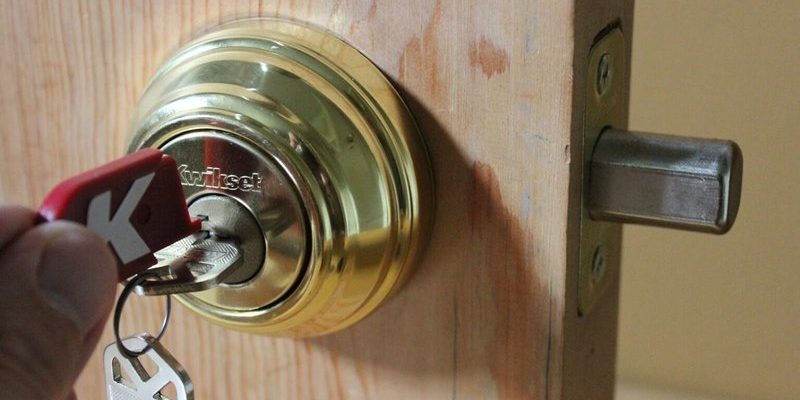
Here’s the thing: keys sticking in deadbolts isn’t just a random fluke. It usually means something’s not quite right inside the lock or with the key itself. And while it might seem like a tiny issue at first, ignoring it can lead to bigger headaches down the road—like a broken key, or a total lockout. Whether you’ve got a classic Schlage, Kwikset, Yale, or another brand, the reasons most deadbolt keys stick are surprisingly similar. Let me walk you through what’s going on, why it happens, and how you can fix it before it turns into a bigger hassle.
Common Reasons Your Deadbolt Key Gets Stuck
Honestly, when you slide your key into a deadbolt and it refuses to budge, it’s your lock’s way of waving a little red flag. The most common culprit? Dirt, grime, and general wear inside the lock cylinder. Over time, dust can sneak into even the best-made deadbolts, mixing with old lubricant and turning into gunk. That gunk can make the tiny pins inside the lock sluggish, which means your key ends up stuck—or, worse, snapped in half if you force it.
Another frequent cause is a bent, worn, or poorly cut key. Even a small nick or warp can stop the key from moving smoothly. If you’re using a key that’s seen better days, or maybe a duplicate that was cut just a bit off, the lock pins might catch and refuse to give. And then there’s the weather: cold temperatures can cause metal parts to contract or moisture to freeze inside, while hot, humid days can make internal components swell and stick.
Sometimes, the issue isn’t with the key or the dirt—it’s the lock itself. Cheap or aging deadbolts can develop alignment problems. If the door or frame has shifted, the deadbolt might not line up perfectly with the strike plate, causing resistance when you turn the key. So if you’ve just had a new door installed, or seasonal weather makes your door swell, take note: misalignment might be your enemy here.
How Deadbolt Locks Work (And Why That Matters)
Let me explain something about how deadbolt locks tick, because knowing what’s happening inside helps make troubleshooting a breeze. Think of your deadbolt as a tiny mechanical puzzle made of springs, pins, and tumblers. When you insert your key, its jagged cuts lift a line of tiny pins to just the right height, letting the inner cylinder turn and retract the bolt. If even one pin isn’t lifted perfectly, the cylinder jams—and your key sticks.
Most deadbolt locks use a system called a “pin tumbler.” Each pin has two parts—an upper and lower half—plus a little spring that pushes them down. The unique pattern of your key moves each pin to form a perfect line (the “shear line”) where the cylinder can rotate. Dirt or rust makes those pins sticky or sluggish. A poorly cut key pushes the wrong pins or doesn’t lift them high enough. If your key slides in, starts to turn, and then freezes, that’s almost always what’s going on.
Smart deadbolts, like some from Schlage or Yale, add electronics but still have backup mechanical keyways that work the same way. Electronic features like code syncing or battery operation won’t help you if the physical part of the lock jams. So, even with the latest gadgets, you can’t skip the basics of key and cylinder care.
Signs Your Lock Needs Maintenance (And What to Watch For)
You might be wondering how to spot trouble before your deadbolt key fully sticks. Here’s a quick checklist: if turning your key feels rough, gritty, or takes more force than usual, that’s a clear warning sign. Another red flag is if your key comes out with metal shavings, which means the lock or key is wearing down—yikes.
Listen for squeaky, crunching, or grinding noises when you turn the key. Those sounds usually mean that the internal pins are dirty or dry. If you notice the key won’t slide in smoothly, or sometimes gets trapped halfway in, that’s your lock asking for help.
Sometimes, it’s about timing. Keys that stick only when it’s humid, raining, or freezing cold might point to internal moisture or swelling. If the lock works fine one day and acts up the next, consider the season before blaming the key. Also, if you’ve had to re-key, reset, or pair your lock recently—especially with brands like Kwikset SmartKey or Schlage Connect—you might be dealing with an installation hiccup or a pin alignment issue.
Quick Fixes You Can Try at Home
Here’s the good news: most sticky deadbolt keys don’t require a locksmith right away. There are a few simple tricks you can try before calling in the pros. Start by making sure your key is clean and undamaged. If it’s bent, chipped, or looks worn, get a fresh copy made from the original, not a duplicate of a duplicate.
Next, gently spray a graphite-based lubricant into the keyway. Avoid oil-based sprays like WD-40—they can attract more dirt and make things worse in the long run. Insert your key, work it in and out a few times, and see if the motion feels smoother. Never force the key; if it feels stuck, wiggle gently rather than cranking harder.
Check your door alignment, too. If you have to lift or push the door to get the deadbolt to lock, try tightening the door hinges or adjusting the strike plate. Sometimes a small tweak is all it takes to get things working again. For electronic locks, make sure the battery isn’t low, as some smart deadbolts can get sluggish or lose sync when power is weak.
When You’ll Need a Locksmith (And Why It’s Worth It)
Let’s be honest—sometimes DIY fixes just don’t cut it. If your deadbolt key is still sticking after you’ve cleaned and lubed the lock, or if you see signs of rust, loose parts, or broken mechanisms, it’s time to call a locksmith. Professional help is especially important if the key is stuck halfway and won’t come out, or if you risk breaking it off inside the lock.
Locksmiths have special tools and know-how for stubborn deadbolts. They can disassemble the cylinder, clean out internal gunk, or replace worn pins and springs. If your lock is old or damaged, they might recommend a new deadbolt—sometimes an upgrade to a smart lock if you’re craving more convenience. Honestly, for the cost of one emergency visit, you’ll often save yourself repeated frustration down the road.
And here’s an expert tip: if you ever have to reset, re-key, or sync (pair) new keys for your lock, ask the locksmith to check the cylinder’s alignment, too. Even with universal lock brands, slight misalignment can sneak up and cause trouble months later.
Preventing Deadbolt Key Problems in the Future
You might be wondering—once you’ve fixed a sticky key, how do you stop it from happening again? Regular maintenance is the secret. Every six months or so, spray a tiny bit of graphite or silicone lock lubricant into the keyway. Avoid oils and greases; they’re like magnets for dust.
Keep your keys clean, too. If you drop your keys in the dirt or sand, or notice rust, wipe them before using them in your lock. Store spare keys in a safe, dry spot so they don’t warp or corrode over time. If you ever notice a new key is stiff right away, don’t wait—get it recut at a higher-quality shop.
For smart or “resettable” deadbolts (like Kwikset SmartKey or Yale’s keyless models), follow the brand instructions when syncing codes or installing new batteries. If your lock allows re-keying, only use original tools and double-check the fit before trusting the new key. Regularly check the battery and reset the code as part of your home security routine—battery problems can sometimes mimic or add to sticky key issues.
Should You Replace or Repair Your Deadbolt?
Sometimes, no matter what you do, that sticky key is just the start of a bigger headache. If your deadbolt is old (think 10+ years) or you keep having to troubleshoot the same problem, it might be time to swap it out for a new one. Modern deadbolts—universal or brand-specific—are often more reliable, secure, and easier to maintain.
Let’s compare: repairing a high-quality lock from Schlage, Kwikset, or Yale can often extend its life by years. But if the cylinder is badly damaged, rusted, or warped, repairing might end up costing more (and wasting more time) than just buying a new lock.
If you decide to upgrade, look for features like anti-pick pins, electronic code options, or even remote pairing with your phone—these can make your daily routine smoother and your home safer. Installing a new deadbolt isn’t hard if you have basic tools, but don’t hesitate to call a pro if you want a flawless fit and peace of mind.
Closing Thoughts: Keeping Your Deadbolt—and Your Key—Working Smoothly
Deadbolt key sticking doesn’t have to be the start of a daily battle with your front door. Most issues come down to dirt, wear, or simple alignment problems. With a bit of cleaning, some smart troubleshooting, and regular maintenance, you can keep your lock turning smoothly for years—whether it’s a classic Schlage, a smart Yale, or a universal deadbolt brand.
The next time your key gets stuck, remember: don’t force it, don’t panic, and don’t wait until it totally jams. Take a breath, give your lock some attention, and fix the problem early. And if things ever get out of hand, a good locksmith is just a call away. Your front door should open like a welcome home—not a wrestling match.
